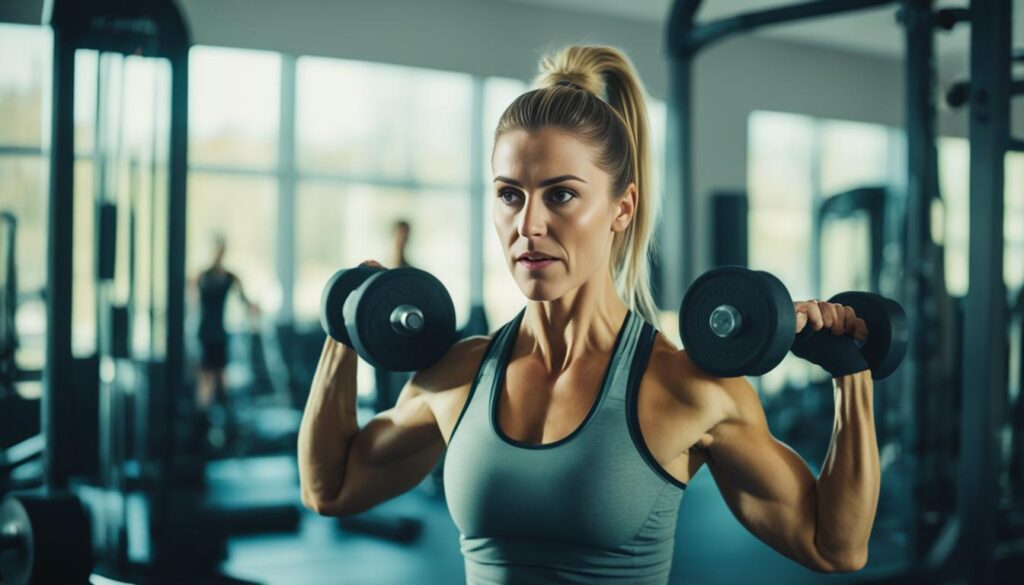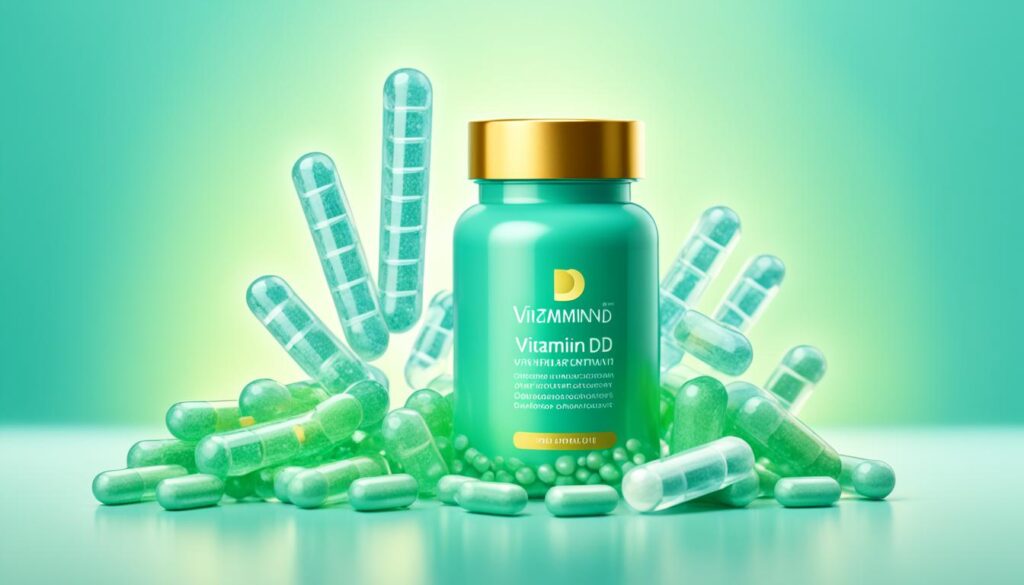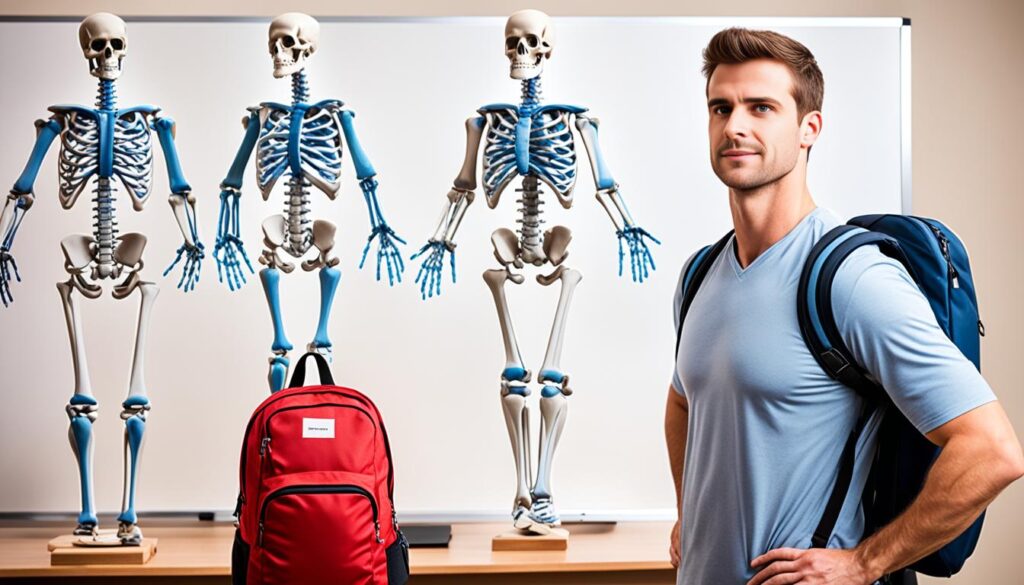Imagine a skeleton so strong, it could withstand time’s and gravity’s forces. It’s a powerful vision for those with osteoporosis. This is a condition where bones become fragile and break easily.
But, what if the secret to stronger bones isn’t just in medicine? What if, through daily movement, you could greatly improve your bone health?
In this guide, we’ll share the best exercises and tips for better bone health. We cover exercises like weight-bearing workouts, strength training, and low-impact aerobics. Plus, we’ll talk about nutrition and supplements. With this information, you can make your skeleton stronger. So, are you ready to learn how to boost your bones’ health?
Key Takeaways
- Osteoporosis is a condition where bones become fragile and prone to fractures.
- Weight-bearing exercises, strength training, and low-impact aerobics can help build and maintain bone health.
- A calcium-rich diet and vitamin D supplements are crucial for optimal bone strength.
- Posture awareness and fall prevention strategies can protect bones from daily strain and injury.
- Regular bone density tests can help monitor progress and guide your bone health management plan.
What are the best ways to exercise and improve your bone health when you have os
Keeping your bones strong is key if you have osteoporosis. But, this doesn’t mean you can’t exercise. There are lots of great exercises to help your bones stay healthy and strong. These include things like walking, lifting weights, and doing exercises that are gentle on your body. Let’s check out the top ways to keep moving and support your bone health with osteoporosis.
Weight Bearing Exercises A Solid Foundation
Weight-bearing activities are super important for those with osteoporosis. These include walking, jogging, and dancing. They help your bones get stronger by putting a little stress on them. Doing these activities can keep your bones from getting weaker. This is key for managing osteoporosis.
Strength Training Building Muscle Building Bone
Strength training is also great for your bones. When you lift weights or do resistance exercises, it builds your muscles. And strong muscles support strong bones. This is really good for people with osteoporosis. It can make your bones denser and lower your chance of breaking a bone.
Low-Impact Aerobics Staying Active Without Strain
It’s good to mix in low-impact aerobic activities with the other exercises. Things like swimming, water aerobics, and cycling are perfect. They keep your heart healthy and don’t put too much pressure on your bones. This is great for your overall health and fitness.
By blending various exercises, including weights, strength training, and low-impact aerobics, you can boost your bone health. This helps lower the risk of fractures and keep you fit and active.

The key to managing osteoporosis is to find a balance between challenging your bones and avoiding excessive impact or strain.
Always talk to a healthcare pro or a physical therapist before starting any new exercise. They can create a plan just for you. With the right exercise plan, you can make your bones stronger, no matter the health challenge.
Weight Bearing Exercises The Foundation of Bone Strength
Weight-bearing exercises are key for strong, healthy bones. They gently press on your bones, making them stronger and more resilient. For those with osteoporosis, these exercises are crucial in fighting this condition.
Walking A Simple Yet Effective Solution
Walking is an easy and effective exercise for battling osteoporosis. It doesn’t impact your joints too much. Plus, it helps make your bone strength better and lowers the risk of fractures.
Start at a pace that’s right for you, then work up to longer and brisker walks. Try to walk for 30 minutes a day, a few days each week, for the best bone health results.
Jogging A Higher Impact Option for Stronger Bones
Jogging is tougher than walking but very good for osteoporosis. It significantly enhances bone strength and density. Begin with short jogs at a slow pace.
Make sure you run correctly and don’t ignore any pain. Increase your jogging slowly as you get fitter. With consistency and care, jogging can greatly help your low-impact activities plan.
Always start weight-bearing exercises at a level that feels good for you. Then, up the challenge gradually. With walking and jogging in your routine, you’ll improve bone health and cut down osteoporosis risks.

Strength Training Muscle Power for Bone Density
Strength training is very important for those with osteoporosis. It helps build and keep bone density strong. By working out your muscles, you also make your bones stronger. This is crucial against osteoporosis.
One big plus of strength training is boosting your muscle power. This helps keep your bones safe and improves how well you move. Begin with light weights and slowly use heavier ones as you get stronger. You can use resistance bands or weights at first.
It’s vital to do these exercises correctly. Focus on smooth, precise movements to get the best results. This also cuts down on injury chances. A professional trainer can help make a workout that’s just right for you. It should work all the big muscles in your body.
| Exercise | Benefits for Bone Density |
|---|---|
| Squats | Strengthens the legs, hips, and core, which are critical weight-bearing areas for bone health. |
| Deadlifts | Engages the entire posterior chain, including the back, glutes, and hamstrings, to build overall muscle strength and bone density. |
| Overhead Press | Targets the shoulders and arms, helping to maintain bone density in the upper body. |
Consistency is key in strength training. Add it to your weekly schedule and slowly intensify it. This way, you’ll boost your bone health and muscle strength over time.

Strength training is a game-changer for individuals with osteoporosis. It’s the secret weapon to building and maintaining bone density and reducing the risk of debilitating fractures.
Low Impact Aerobics Keeping Bones Healthy Without Strain
For healthy bones, weight-bearing exercises are key. But those with osteoporosis should add low-impact aerobics too. Water aerobics and cycling are great choices. They help with heart health without too much stress on bones.
Water Aerobics A Gentle Yet Effective Workout
Water aerobics is a top pick for a gentle workout. It’s done in the pool, so there’s less stress on the joints. The water’s buoyancy supports your weight, lessening the stress on bones and muscles. Plus, it tones your muscles, boosting bone health.
Cycling: A Low Impact Way to Stay Active
Cycling is another brilliant exercise for those with osteoporosis. You can ride indoors or outdoors. It’s great for your heart and easy on the bones. Unlike running, cycling is joint-friendly. It keeps your heart healthy while caring for your bones.
It’s crucial to talk to your doctor before starting any exercise plan. They can help you pick the best mix of exercises. This will keep your bones and body in great shape without overdoing it.

Low-impact aerobics with water and cycling are a win for osteoporosis. They keep you active and help your bone health, gently.
The Importance of a Calcium Rich Diet
Eating enough calcium is key for those with osteoporosis. It helps keep bones strong and dense. This nutrient is vital for those worried about their bone health.
Dairy Products A Delicious Source of Calcium
Milk, cheese, and yogurt are tasty, available sources of calcium. They help you reach your daily calcium needs. For example, a cup of milk gives you 300 milligrams of calcium, which is 30% of what you need in a day.
But, if you can’t have dairy or prefer other options, don’t worry. You can get calcium from plants and nuts. Leafy greens, tofu, almonds, and fortified cereals and juices are all good choices. Adding these foods to your meals ensures your bones stay healthy.
| Calcium Rich Food | Calcium Content per serving |
|---|---|
| Milk 1 cup | 300 mg |
| Yogurt 1 cup | 415 mg |
| Cheddar Cheese 1 oz | 204 mg |
| Spinach 1 cup cooked | 245 mg |
| Tofu 1/2 cup | 204 mg |
Adults need 1,000-1,200 milligrams of calcium every day. This varies by age and gender. Eating a variety of calcium-rich foods is good for your bones. It also lowers your chances of getting osteoporosis.

Vitamin D Supplements Boosting Calcium Absorption
Holding onto strong bones is key for those with osteoporosis. Vitamin D helps our bodies absorb calcium and builds stronger bones. We will discuss why vitamin D is so important and how to add it to your day.
Vitamin D boosts bone strength by helping calcium work better. If we don’t get enough vitamin D, our bodies can’t use the calcium we eat. This lack of calcium can lead to osteoporosis.
For adults with osteoporosis, it’s usually recommended to take 600 to 800 IU of vitamin D daily. But, everyone’s needs are different, depending on age and how much sun you get. It’s smart to talk to a doctor before taking any supplements to make sure you’re using the right amount.
There are many ways to take vitamin D. You can choose from softgels, capsules, or liquids. Some people like to take their vitamin D with a calcium supplement for extra bone health.
| Supplement | Dosage | Potential Benefits |
|---|---|---|
| Vitamin D3 | 600-800 IU per day | Enhances calcium absorption, supports bone density |
| Calcium + Vitamin D | Calcium: 1,000-1,200 mg per day Vitamin D: 600-800 IU per day |
Provides a comprehensive approach to bone health |
Adding vitamin D to your daily plan can really help your bones. With a diet rich in calcium, these supplements work well together. This can keep your bones strong and lower the chance of breaks.

Vitamin D is essential for the proper absorption and utilization of calcium, which is the primary building block of our bones.
Posture Awareness Protecting Your Bones from Daily Strain
Maintaining proper posture is key for good bone health, especially for those with osteoporosis. Bad posture can stress your bones too much, which raises fracture risk. It can also hurt your whole skeletal system. We will look into why keeping good posture matters and how it can be done.
For osteoporosis patients, keeping the right posture is very important. When you slouch or twist in ways that hurt your spine, you stress weak bones. Eventually, this can cause bad spinal fractures, which hurt a lot and limit movement. But, if you make a conscious effort to stand and sit straight, you can save your bones from a lot of harm. This also lowers the chances of you falling or getting fractures.
Practicing Good Posture During Daily Activities
Being aware of your posture every day can change your bone health for the better. A few things can help keep your posture right:
- When sitting, stay straight and pull your shoulders back. Don’t slouch or lean forward, as this may hurt your spine.
- Stand correctly when you cook or do laundry. Make sure your back is in line and tighten your core to keep it there.
- While walking, lift your head, push your shoulders back, and look straight ahead. Don’t let your phone or other device pull your head down.
- When picking up or carrying stuff, fold at the knees and hips while keeping your back straight. Try not to twist or bend your spine.
Adding posture-focused workouts, like yoga or Pilates, to your schedule is another great move. These can boost your body’s sense of alignment and why it matters to keep a good posture. Doing them regularly can better your balance, make you more flexible, and strengthen your body. This will also cut down the risk of falling or getting fractures.
Remember, being mindful of your posture isn’t only about looks. It’s critical for your bone health and keeping osteoporosis risks at bay. By focusing on keeping a good posture each day, you’re actively caring for your bones and overall health.

Proper posture is not just a matter of appearance it’s a vital aspect of bone health and fall prevention for individuals with osteoporosis.
Fall Prevention Strategies Keeping Bones Safe
It’s important to avoid falls to keep your bones strong, especially for those with osteoporosis. With the right fall prevention methods and balance exercises, you can cut the chance of getting hurt. This protects your bones.
Balance Exercises Improving Stability and Coordination
To stop falls, work on your balance and how well you move. Adding balance exercises to your day makes sure you can keep steady. This helps you feel surefooted as you go about your daily life.
- Stand on one leg: Challenge your balance by standing on one leg gradually increasing the duration as you improve.
- Tandem walking: Walk in a straight line, placing one foot directly in front of the other, like walking on a tightrope.
- Tai Chi: This ancient Chinese practice combines gentle movements and breathing techniques to enhance balance and coordination.
When doing these exercises, think about your safety first. It’s smart to get advice from a physical therapist or a trained instructor. They can help you do the exercises in a way that’s safe and effective.
| Balance Exercise | Benefits | Difficulty Level |
|---|---|---|
| Stand on one leg | Improves stability and coordination | Beginner |
| Tandem walking | Enhances agility and balance | Intermediate |
| Tai Chi | Combines balance, strength, and mindfulness | Advanced |
Adding these exercises to your routine boosts your balance and coordination. Doing them regularly builds your confidence in moving around safely. Remember to keep at it. Making fall prevention a habit is a great way to look after your bones.
Bone Density Tests Monitoring Your Progress
For those with osteoporosis, getting regular bone density tests is a must. It helps track if your treatment and exercises are working. This way, you and your doctor can know what’s best for your bones.
Dual-energy X-ray absorptiometry DXA scans are used for bone density testing. They check how much mineral and density bones have. This data is key for seeing if osteoporosis is getting better or worse. Also, it shows if your efforts to make your bones stronger are working.
Talking often with your healthcare provider is important. They will know how often you should get tested. Usually, it’s once or twice a year. But, this depends on how bad your osteoporosis is and your specific needs.
The Benefits of Regular Bone Density Testing
- Tracks the progression or regression of osteoporosis over time
- Helps evaluate the effectiveness of your exercise and treatment plan
- Allows for early detection of bone loss, enabling proactive interventions
- Provides a baseline for comparison, helping you monitor your progress
Getting bone density tests done regularly is important. It helps you and your doctor ensure your bones are getting stronger. Working together like this is very important in managing osteoporosis and avoiding fractures.
| Bone Density Test Frequency | Osteoporosis Severity |
|---|---|
| Once a year | Mild to moderate osteoporosis |
| Twice a year | Severe osteoporosis or high risk of fractures |
Keep in mind looking after your bone health is a long-term effort. Regular tests are vital for tracking how you are doing. And this helps in making smart choices about your health.
Bone density tests are a valuable tool in the management of osteoporosis, allowing healthcare providers to closely monitor changes in bone health over time.
Conclusion
Maintaining strong bone health is key when dealing with osteoporosis. It takes a mix of good exercises, eating foods high in calcium, plus vitamin D, and making sure to avoid fall risks. By doing these, you can lower the chance of breaking bones.
Make sure to talk to your doctor. They can help you set up an exercise and treatment plan just for you. With their help and your hard work, healthier, stronger bones are within reach. This will let you enjoy an active life without fear of fractures.
Cheers to your bone health journey! Here’s to a future full of energy, freedom, and the chance to follow your dreams. Your actions can make a big difference in your bone strength. So, take care of your bones to the best of your ability!





